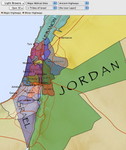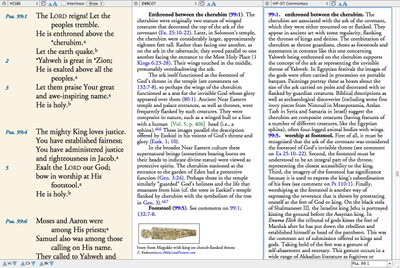Over the past several posts, I’ve discussed the challenge of having a regular time of family Bible reading, and offered seven tips for successful family devotions (1-3, 4-7). In the process, I’ve revealed quirky things about my family, such as our tendency to shout out Hebrew words and our willingness to resort to violence in order to memorize Scripture. Today, I want to point you to some of the Accordance resources I’ve found particularly helpful during family devotions.
 Graphic Resources. The Atlas, Timeline, and PhotoGuide have all repeatedly proven indispensable. Any time there is a significant reference to a place, I’ll simply select the place name and click the Map button. The Atlas opens to find that place, and I can overlay any site, region, and route layers I want. This ability to create a custom map on the fly makes it easy to explain the geography behind a passage. If I want to show pictures of a place, I double-click the place name on the map to open the PhotoGuide. It’s amazing how much a map or some photos can help solidify our understanding of the Biblical text.
Graphic Resources. The Atlas, Timeline, and PhotoGuide have all repeatedly proven indispensable. Any time there is a significant reference to a place, I’ll simply select the place name and click the Map button. The Atlas opens to find that place, and I can overlay any site, region, and route layers I want. This ability to create a custom map on the fly makes it easy to explain the geography behind a passage. If I want to show pictures of a place, I double-click the place name on the map to open the PhotoGuide. It’s amazing how much a map or some photos can help solidify our understanding of the Biblical text.
Background Commentaries. Not long ago, I gave an example of how I use the background commentaries by Zondervan and IVP to help me explain the historical background of a passage. In that post, we were reading two short psalms with references to different aspects of the temple in Jerusalem. By adding a couple of background commentaries in parallel panes, I had access to concise explanations of the temple references without having to wade through a lot of other commentary.
Study Bibles. Accordance offers a number of excellent study Bibles, and these are likewise very helpful when you’re trying to explain a passage to your family. When you’re explaining a passage extemporaneously and you run into something you need help with, you simply don’t have the time to read a commentary on the passage. But study Bibles are like mini-commentaries, offering the kind of concise explanation that helps you keep reading for understanding. Like the background commentaries, they can be displayed in parallel with the Bible text so that they scroll along.
The common thread in all these resources is that they offer quick access to the information necessary to understand the passage you’re reading. Commentaries and dictionaries are wonderful resources, but I rarely use them during family devotions because they tend to require too much time to sift through. The resources I consult during devotions are those which give me just enough help to keep going without getting bogged down. In my next post, I’ll point you to what I think is the best overall source of help for successful family devotions.


